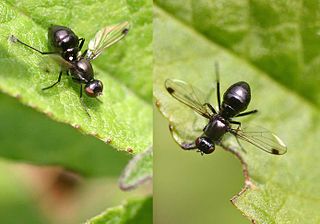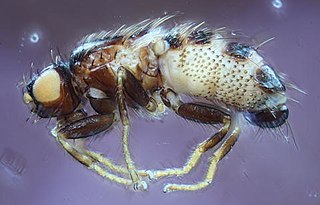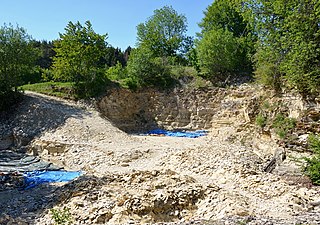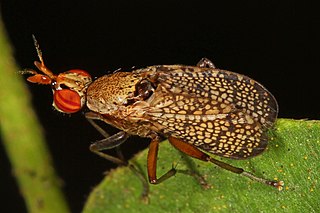
Emil Hans Willi Hennig was a German biologist who is considered the founder of phylogenetic systematics, also known as cladistics. In 1945 as a prisoner of war, Hennig began work on his theory of cladistics, which he published in German in 1950, with a substantially revised English translation published in 1966. With his works on evolution and systematics he revolutionised the view of the natural order of beings. As a taxonomist, he specialised in dipterans.

The Sepsidae are a family of flies, commonly called the black scavenger flies or ensign flies. Over 300 species are described worldwide. They are usually found around dung or decaying plant and animal material. Many species resemble ants, having a "waist" and glossy black body. Many Sepsidae have a curious wing-waving habit made more apparent by dark patches at the wing end.

Dominican amber is amber from the Dominican Republic derived from resin of the extinct tree Hymenaea protera.

Carnidae, also known as Bird flies or Filth flies, is a family of flies (Diptera). There are 6 genera, containing about 93 species worldwide.

The Acartophthalmidae are a family of very small (1.0-2.5 mm), dark flies with pubescent arista, placed in the order Diptera. All are Holarctic in distribution. Two fossil species are known, with uncertain placement.
Clematochaeta is a genus of tephritid or fruit flies in the family Tephritidae.

Noeeta is a genus of tephritid or fruit flies in the family Tephritidae.

Adia is a genus of flies in the family Anthomyiidae.
Phasia aldrichii is a tachinid fly found throughout most of North America.

Carnus is a genus of flies (Diptera) with 5 described species, all of which are parasites of birds. The adult flies locate a suitable host nest, then shed their wings and feed on the blood of the developing nestlings. Mature female flies lay their eggs in the nest, where their larvae develop on organic detritus.
Neomeoneurites is a genus of flies (Diptera). There are 2 described species.

The Cryptochetidae are a small family of tiny flies. Some twenty to thirty species are known. Generally they are metallic blue black, stoutly built, with the head broad and high and with clear wings. Like other species in the superfamily Lonchaeoidea, the Cryptochetidae have antennae with a cleft in the second segment. Unlike practically all Schizophora however, they lack an arista, or if they do have one, it is too small to distinguish with any confidence. The family name refers to this unusual distinction; "Cryptochetidae" literally means "those with hidden bristles". The adult flies also are unusual among insects in that they have only a single pair of abdominal spiracles — this is not a serious physiological challenge in such small insects.

The Nusplingen Limestone is a geological formation in Baden-Württemberg, Germany. It preserves fossils dating to the Kimmeridgian age of the Late Jurassic. It mainly consists of lithographic limestones deposited in a marine basin, similar to the Solnhofen Limestone. Fossils of pterosaurs, thalattosuchians, and the oldest geophilomorph centipede Eogeophilus were found in the Nusplingen Limestone.
Lygiohypotyphla is a genus of flies in the family Pyrgotidae.
Metropina is a genus of flies in the family Pyrgotidae.

Tetanocerini is a tribe of flies in the family Sciomyzidae. There are more than 400 described species in the tribe.

Sciomyzinae is a subfamily of flies in the family Sciomyzidae.

The Sachrang Formation or "Posidonienschiefer" Formation is a geological formation of southwestern Germany, northern Switzerland, northwestern Austria, southeast Luxembourg and the Netherlands, that spans about 3 million years during the Early Jurassic period. It is known for its detailed fossils, especially sea fauna, listed below. Composed mostly by black shale, the formation is a Lagerstätte, where fossils show exceptional preservation, with a thickness that varies from about 1 m to about 40 m on the Rhine level, being on the main quarry at Holzmaden between 5 and 14 m. Some of the preserved material has been transformed into fossil hydrocarbon Jet, specially wood remains, used for jewelry. The exceptional preservation seen on the Posidonia Shale has been studied since the late 1800s, finding that a cocktail of chemical and environmental factors let to such an impressive conservation of the marine fauna. The most common theory is the changes on the oxygen level, where the different anoxic events of the Toarcian left oxygen-depleted bottom waters, with the biota dying and falling to the bottom without any predator able to eat the dead bodies.
Phanerochaetum is a genus of flies in the family Cryptochetidae. There is one described species Phanerochaetum tuxeni.
Protorygma is an extinct genus of flies in the family Sepsidae.













